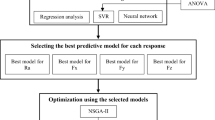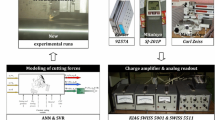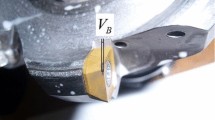Abstract
This study examines the influence of cutting speed, feed, and depth of cut on surface roughness in face milling process. Three different modeling methodologies, namely regression analysis (RA), support vector machines (SVM), and Bayesian neural network (BNN), have been applied to data experimentally determined by means of the design of experiment. The results obtained by the models have been compared. All three models have the relative prediction error below 8%. The best prediction of surface roughness shows BNN model with the average relative prediction error of 6.1%. The research has shown that, when the training dataset is small, both BNN and SVR modeling methodologies are comparable with RA methodology and, furthermore, they can even offer better results. Regarding the influence of the examined cutting parameters on the surface roughness, it has been shown that the feed has the largest affect on it and the depth of cut the least.
Similar content being viewed by others
References
Colak O, Kurbanoglu C, Kayacan MC (2005) Milling surface roughness prediction using evolutionary programming methods. Mater Des 28:657–666
Bajić D, Belaić A (2006) Mathematical modeling of surface roughness in milling process. In: Proceedings of the 1st International Scientific Conference on Production Engineering (ISC), Lumbarda, Croatia, June/July 2006, pp 109–115
Lou MS, Chen JC, Li CM (1998) Surface roughness prediction technique for CNC end-milling. J Inf Technol 15(1):2–6
Lu C (2008) Study on prediction of surface quality in machining process. J Mater Process Technol 205:439–450 doi:10.1016/j.jmatprotec.2007.11.270
Oktem H, Erzurumlu T, Kurtaran H (2005) Application of response surface methodology in the optimization of cutting conditions for surface roughness. J Mater Process Technol 170:11–16 doi:10.1016/j.jmatprotec.2005.04.096
Benardos PG, Vosniakos GC (2002) Prediction of surface roughness in CNC face milling using neural networks and Taguchi’s design of experiments. Robot Comput Integr Manuf 18:343–354 doi:10.1016/S0736-5845(02)00005-4
El-Sonbaty IA, Khashaba UA, Selmy AI, Ali AI (2008) Prediction of surface roughness profiles for milled surfaces using an artificial neural network and fractal geometry approach. J Mater Process Technol 200:271–278 doi:10.1016/j.jmatprotec.2007.09.006
Dong J, Subrahmanyam KVR, Wong YS, Hong GS, Mohanty AR (2006) Bayesian-inference-based neural networks for tool wear estimation. Int J Adv Manuf Technol 30:797–807 doi:10.1007/s00170-005-0124-8
Choa S, Asfoura S, Onarb A, Kaundinya N (2005) Tool breakage detection using support vector machine learning in a milling process. Int J Mach Tools Manuf 45:241–249 doi:10.1016/j.ijmachtools.2004.08.016
Hsueh, YW, Yang CY (2008) Tool breakage diagnosis in face milling by support vector machine. J. Mater. Process. Tech. doi:10.1016/j.jmatprotec.2008.01.033
Box GEP, Draper NR (1987) Empirical model building and response surfaces. Wiley, New York
Campbell C (2002) Kernel methods: a survey of current techniques. Neurocomputing 48:63–84 doi:10.1016/S0925-2312(01)00643-9
Vapnik VN (1995) The nature of statistical learning theory. Springer, New York
Vapnik VN (1998) Statistical learning theory. Wiley, New York
Nash S, Sofer A (1996) Linear and non-linear programming. McGraw-Hill, New York
Twomey JM, Smith AE (1998) Bias and variance of validation methods for function approximation neural networks under conditions of sparse data. IEEE Trans Syst Man Cybern 28(3):417–430
Rivals I, Personnaz L (1999) On cross-validation for model selection. Neural Comput 11(4):863–870 doi:10.1162/089976699300016476
Lagarias JC, Reeds JA, Wright MH, Wright PE (1998) Convergence properties of the Nelder–Mead simplex method in low dimensions. SIAM J Optim 9(1):112–147 doi:10.1137/S1052623496303470
Mackey DJC (1992) Bayesian methods for adaptive models. PhD Dissertation, California Institute of Technology
Bishop C (1995) Neural networks for pattern recognition. Oxford Univ. Press, UK
Author information
Authors and Affiliations
Corresponding author
Rights and permissions
About this article
Cite this article
Lela, B., Bajić, D. & Jozić, S. Regression analysis, support vector machines, and Bayesian neural network approaches to modeling surface roughness in face milling. Int J Adv Manuf Technol 42, 1082–1088 (2009). https://doi.org/10.1007/s00170-008-1678-z
Received:
Accepted:
Published:
Issue Date:
DOI: https://doi.org/10.1007/s00170-008-1678-z




